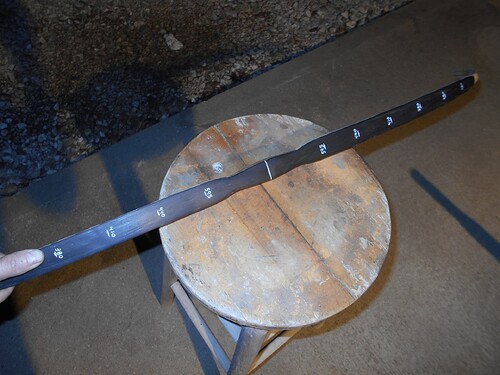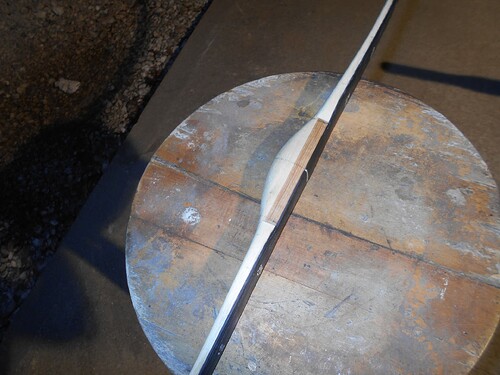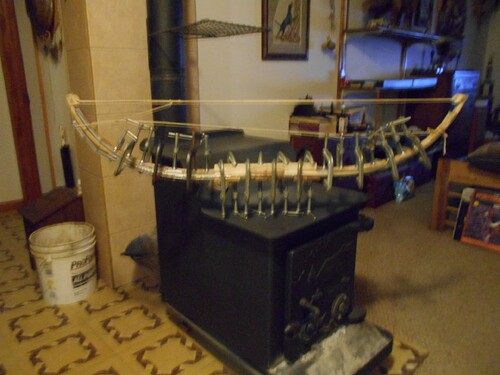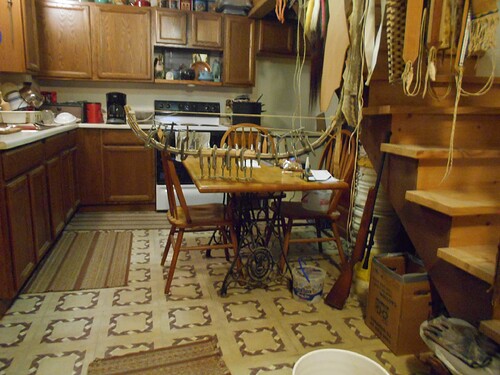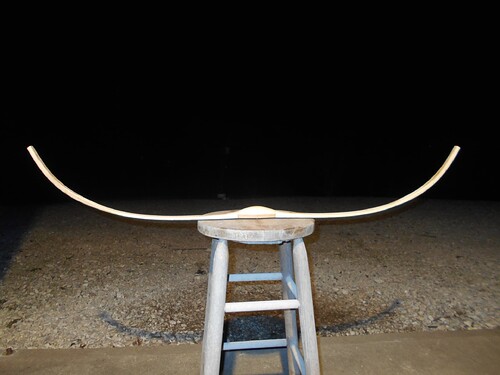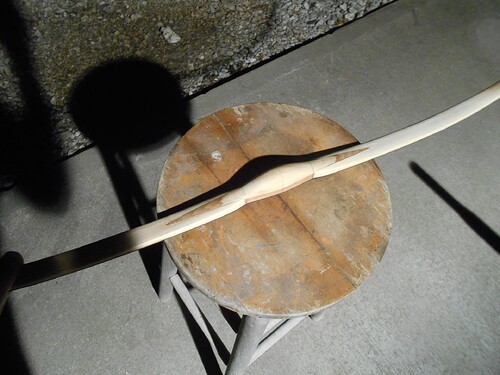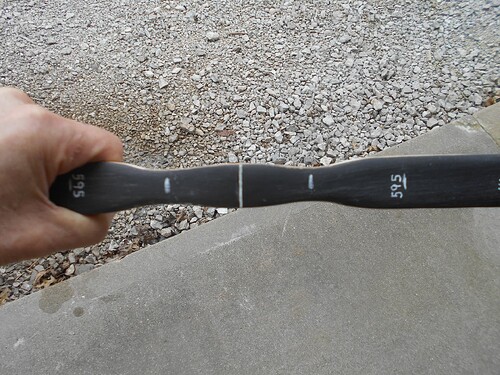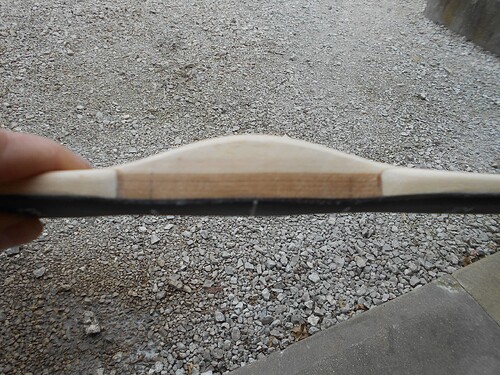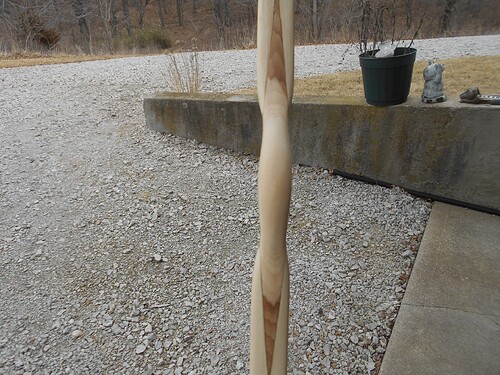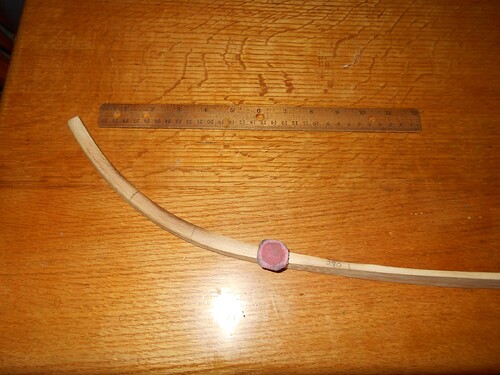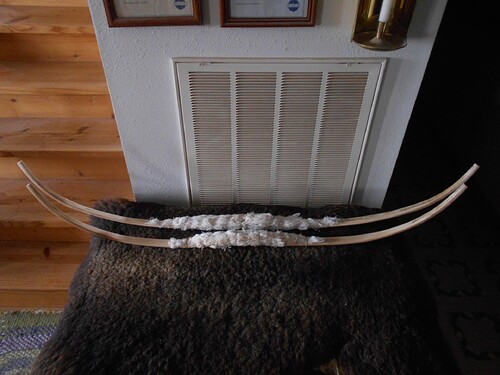Thanks for the reference of the rules.Almost nothing modern the way I like it…ha ha.Their probably the same at the salt flats in the states correct?
The only two times I used the tencik method I was impressed by how much pressure it had.
I tighten C clamps pretty darn tight myself also,making sure surface is wetted properly.No dry or air joints.I’d rather clean up the mess from the squeeze out.
I believe our brains are wired or accustomed to what we are used to doing with bows so it’s sometimes difficult to see the other way.No matter there are related overlapping likeness’s that are worth talking about.
Anyway some more progress on this bow to show a little action on this site.
The deflex seems to have been diminished some,but it’s still there and I’m sure will reveal itself more when tillering.
Good wood to horn joinery and alignment is good with invisible glue lines now too.Thickness tapering rounding of horn and core is done and it is ready for sinewing.
Not as much preloaded reflex in core as Jere suggested.Sorry Jere…ha ha.The perry reflex glue line gave it a few more inches.
Sinewing it will give it 7 or 8 more inches I imagine.Reverse bracing more the whole while in between courses.
I’ve got one other “normal” handled bow for lack of a better description ready for sinewing also and the sinew is stripped and sorted for it.I’ll have to strip out more for this bow.I might just chase after this bows sinewing first though as it is a bit different and a little more interesting to me.
Mostly all good long moose and elk leg sinew with some horse in the also that I will use.Around a good 2 ounces or 56 grams or so.
I’m thinking most of sinew on the handle will be over top for handle depth.A little on the sides.Covering ends of splice well.
I feel I’ve got some reducing to do on the handle yet before sinewing.A question about how narrow one can make the arrow pass for safe usage before sinewing?Although from what I’ve seen the handle is not one of the places the bows on here fail.
I would like to get my arrow pass as narrow as possible with final filing ect…I do on most all bows I make.Although I do not like to go to 5/8" wide if I can help it.The old theory of almost twice as thick as narrow for safety reasons I go by here.
Usually down to 3/4" or 20 mm or so finished is safe enough for me.Accuracy wise I just like it better.I get to use stiffer longer arrows then also.Usually the arrow pass is around 1.5" above the center of the bow.
I notice with bows made for flight shooting that the handle made needs to allow for the siper and the 0 ring.Thus shooting a bit outside the center shot position of the arrow.With shorter stiffer arrows I’m sure the paradox is reduced yet though.Which I feel can reduce the distance an arrow goes or it’s speed also.
In the end the 52" bow will be drawn to 28".I shoot with the split 3 finger release.Don’t know how much over draw they call that,but to me it’s 4" over draw???Hope and it should’nt with recurves the way they are stack much at full draw…ha ha.
What I’m doing my bow making friends is making shorter and shorter bows to try to get more out of the horn and sinew which I’m sure it can handle.Who knows there might come a point when I’ll have to make forms/make convex and concave toothed grooving tools to make these turkish horn bows.I’d rather ease my way into it for now.
It should’nt be much of a contact recurve.Sort of a working recurve without any kick at all while shooting.I’ve heard some call the contact recurve kick the manchu kick??? because of the string slapping against the recurves tips on these longer bows.
I must say again I do not like the way windows 10 uplaods my pictures.It puts them at random into anywhere in my pictures file.Takes a while to find them all.
I see I’ve almost written a book here…ha ha.
The darker wood in handle is the heartwood of the hickory of course.I did not use the osage handle.The sapwood rings in the limbs run close to 25 rings per inch.
Thinking of using thin stained leather on the handle with either goat or deer rawhide or maybe flathead catfish skins if I can get them on the limbs.I like the varigated colors that flathead catfish skins have.
That’s quite a ways off yet though and I could change my mind about that.
I figured this handle reducing stuff was’nt all that hard so I went ahead and did what I thought was right.Saw a picture of one of Adams’ handles done flattened out on the sides to accept sinew along handle and across to the limbs.
Picture of results show it to be 3/4" wide at arrow pass chalk marks 1 " deep.The celik at the center is 1" wide 1 and 5/16" deep.After sinew width measurements ought to be about right I figure or can a person go narrower yet before sinew?To me not all that much sinew needs to be laid across the arrow pass area.
Feels comfortable to me.So if string lies to one side of center or not I’ll now what limb to be the top limb.
About measuring overdrawing on 52" bow drawing 28".There might be a formula for this ,but I believe that would only be 2".I could be wrong here though thinking half the length of the bow.Dividing 52" by 2 to get 26".
So a 48" bow drawn to 28" would be a 4" overdraw.
No matter it’s not something that these horn bows on here need to be concerned about.
Handle looks really nice already. I agree, about 20mm wide is something i would use at that long bow. We do go narrower for flight bows, but what is clever to do is use less sinew in grip sides. Wood is stiffer so then the grip can be made effectively even narrower at arrow pass.
If handle (arrow pass included) is too narrow, there might be sideways bending happening, which will make the bow unstable. Really annoying.
Took me a while to understand what you meant with overdraw. In terms of stress yes, even the half of bowlength draw for woodbow is a lot. Hornbows can go 70%. Drawlength is basically only limited with stacking.
Yes I agree.It’s unbelievable what these horn bows will take.Seems they are almost unbreakable since I’m more used to making bows from all wood.Like you said limited to the stacking point and that’s it.
I’m not one to risk stability for centershot convenience though.That does not make sense to me.
I’ll find a happy medium finishing it.
Update that I will show later…I’ve got one more core and handle ready for horn.I will try to preload that core a bit with another bend using a heat gun 6 to 7 inches down from the tip bend to give it more set back.Been reading Adams’ book a lot.He says like you said it’ll help to make the core hold the reflex more there than depending on the sinew to do it.Hope I’ve got enough wood there though to make a difference.I might crown the sinew a little more there,but that might be a negative mass weight wise or a wash.
Somewhere around where
the eraser sets on the limb there.I should have a tighter bend out towrads the tip though.That’s already steam bent in though.When rebending wood you may know this also it has to be clamped down other wise it will return to it’s original profile.
Its always good to have many projects! Different shape and sizes helps to learn variety of bowmaking.
Adam is a big believer of high core reflex.
Well I
got my sinew stripped,divided and bundled for 3 courses apiece on each bow.
Each bow will get at least 12" reflex put to it.
Some of that moose leg sinew or at least a 300 grain course is 20" long.I’ll use that as the last course on the longer bow.
I should have the bows finished by early fall.
Looking forward to the outcome.
Hi, I’m new to all this so apologies if this is the wrong thread to be asking my question. Attempting a horn bow. Have watched a ton of YouTube and read through a lot of y’all’s posts and Adam Karpowicz book.
Big question I have: does anyone use modern commercial wood adhesive for the splices/lamination? I know that takes away from the purely traditional methods, but with my limited resources I’m curious if liquid nails or seekaflex or others would be durable/flexible enough for the strains placed on the bow.
Having Adams’ book I would I would not change the process much.Either using good hide/sinew or croaker bladder or sturgeon glue.
Success can be done with a good quality epoxy like smooth on only with joinery.
Through usage learning the ups and downs of usage of each glue is a learning process.Each have their own conveniences.
Natural glues are really the best throughout the whole process.
It’s a process where a person learns patience,but worth the wait.
Setting up multiple bows can speed the process along.If one fails move on to the other.
Thanks, Ed. Makes sense. Do you recommend buying pre-cut horn or purchasing whole horn and cutting it myself?
Not knowing what types of horn bows you would like to make I’d say that’s up to you.Each has it’s own amount of work to be done.If you have Adams’ book I’d go from his reccomendations.
Agree with Ed.
With horn its a bit tough to get good material. For a beginner, even sawing a horn might be complicated.
But basic rule is, try to source all materials original condition so that no one else has had possibility to ruin them! Maple can be stored badly and be invested with fungus, horn can be cut twisted, sinew can be rotten… I don’t want to bring you down, but just state the reality of this process. ![]()
Yes I’d say find a good supplier if you can’t supply yourself with material from your surrounding area.
Most suppliers are pretty decent.Ones that make their own horn bows are the best as they know what is required.Especially horn.
Sinew and glue is important too but depending where you are from shipping can be restrictive.You can make your own glue.
It’s a feeling out process establishing your connections.
Good advice from both Jere and Ed. Horn can be a challenge to get good quality for any type of bow. I buy mi e in prepared roughed strips from noorbaba online or Facebook. This being said I have to pick through them to get good ones. They usually sell for about 30$ a pair. As for sinew I process my own. I know this sounds intimidating but it really is the way. You can purchase good stuff online and really save yourself time but if on a budget all I do is go to the local butchers and get the legs of moose deer elk that they discard. There are lots of YouTube vids too on how to process your own but basically use sharp knife and get to work cutting away tendon and letting them hang to air dry. For your hide glue again I make my own from the scraps of hide and sinew. I use an old crock pot that has a “warm” setting and let at the 60-65 degrees for a couple days. This will give great glue. Hide glue can be purchased too though. I have also had some good results on milder horn bows using smooth on ea40 like Ed mentioned. I’ve heard that other have used west systems with some success also for splicing and horn glue up. I’ve used only these two epoxy’s so far so there may be others out there good too. The key thing to remember with horn glue up is to prep well and choose good horn. These days I have switched to only using sturgeon glue for horn glue ups. I do use my sinew glue for sinew and other construction. I personally like the longer working gel time and slight edge on flex it has. Lots here but for a guy looking to get started there are no shortcuts with horn bows of any variety. The material is just too valuable to waste on not following some of the tried and true methods. Ya you can tweek things here and there or modify to a certain degree but there comes a time when you realize that the old ways were best actually and soon find that there was reasons for the way they did things. Best of luck!
Thanks all, very much appreciate the advice. Will probably ask more questions as I get further into it. I’m excited for the challenge. Just in the wood selection process right now. Wanting to make an ottoman bow. Hard maple is hard to find where I am. Saw one of your comments about hickory in another thread. Going to experiment with red oak but it seems like it may not have the elasticity for the stresses of an ottoman bow. Any thoughts on that?
Yes I’ve used hickory many times.Ironwood is a good wood to use also being diffous pourus with good elasticity and density.
I wonder about yellow birch also.
Most are using a good hard maple.
We had a bad ice storm here last weekend. Lots of trees went down everywhere. Many still without power. We lost a couple trees and one was a sugar maple. I may cut the rest of it down for bow material in a couple weeks. I’ll post some pics on this site to see if any of it would be a good candidate for limbs. It’s one of our sugar maple that we tapped for sap. Sad to loose it but that’s the way it goes. There is a straight section from the grown up to about 7’. Might as well make it useful. If anything it will be good firewood one day.
